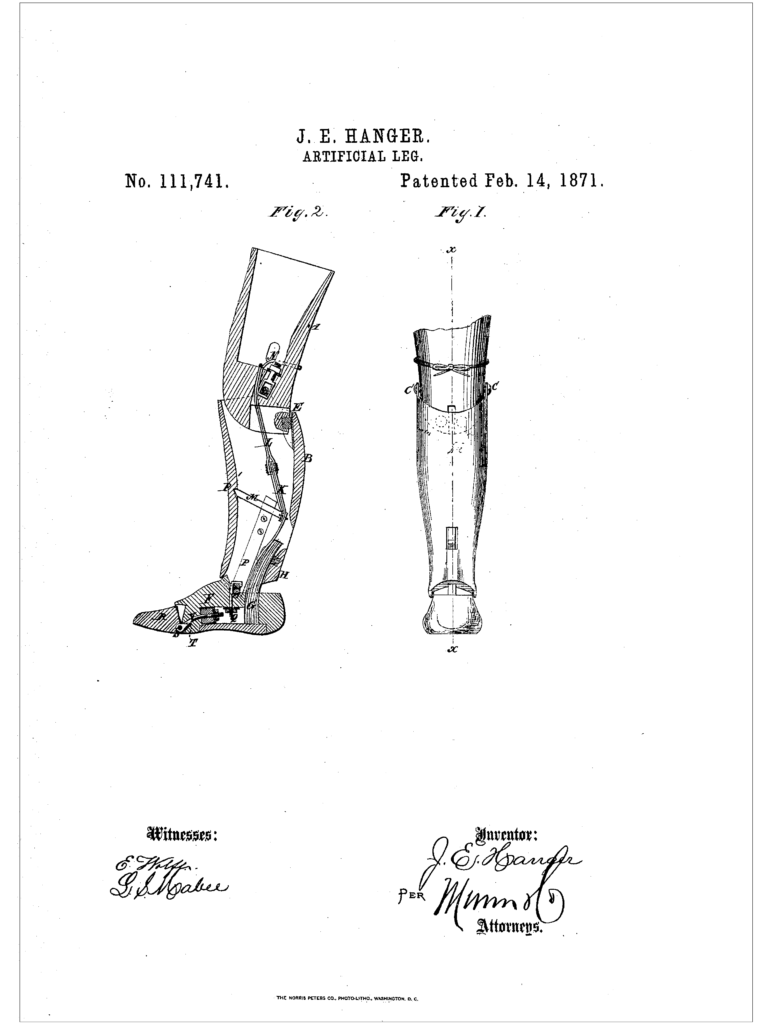
The end of this week marks the 149th anniversary of U.S. Patent No. 111,741, filed on February 14, 1871, by James E. Hanger of Staunton, Virginia, for “Improvement in Artificial Legs.” The main innovations Hanger claimed were dual capacities in the knee and ankle joints: They could flex for mobility and lock for stability. As described in the patent application:
“The pivot C, in the rear of the center rubber cushion D, pad E, and leg B, combined as described with thigh A having solid knee protruding within the leg piece, all for the purpose of forming an improved knee joint.”
Hanger also sought patent protection for an articulating foot mechanism that provided better shock absorption by means of a spring, cord, and deflecting bar.
It was the culmination of nearly a decade’s work, which began in August 1861 after Hanger (then only 18 years old) returned home from a Civil War prison camp sans his right leg from above the knee. He tossed aside the standard-issue wooden peg the Confederate army provided, and by November of that year he’d outfitted himself with a walkable prosthesis fashioned primarily from barrel staves. Before the war was over, he’d won a contract from the Confederate government to furnish prosthetic limbs to the Association for the Relief of Maimed Soldiers.
It was a remarkable ascent for the young inventor, but Hanger’s design was still very much a work in progress. Here’s how Dr. William Carrington, the Association’s secretary, reviewed the product circa 1865:
“[The leg] is rude in workmanship, the color is unsightly, the toes are not fastened by hinges, the braces to the knee are too straight and not curved to the convexities of the knee — the sole leather thigh box is made of leather much too rough . . . . . I am dissatisfied with the leg and hope you will not pass any more such, as they are a discredit to the Association and will be of little use to the men.”
Brutal. Hanger kept refining his design after the war, in which more than 50,000 men lost at least one limb. His main competitor, Dr. Douglas Bly of Richmond, briefly eclipsed Hanger with his patented “Anatomical Leg,” celebrated primarily for its lifelike ankle joint.
But in spite of Bly’s obdurate self-promotion, his creation is barely remembered today. Patent No. 111,741 set a new standard in prosthetic technology and vaulted Hanger to the forefront of the industry, a position the company has held ever since. The original patent is available on Google at https://patents.google.com/patent/US111741A/en.
There’s a lot more to James Hanger’s story, which you can explore at:
- Hanger’s website
- Matt Lively’s Civil War Profiles blog
- The Dictionary of Virginia Biography
- The Emerging Civil War blog
- James Robertson, After the Civil War: The Heroes, Villains, Soldiers and Civilians Who Changed America (National Geographic Society, 2015)
- “How a One-Legged Rebel Lives,” in Katherine Ott et al (eds.), Artificial Parts, Practical Lives: Modern Histories of Prosthetics (NYU Press, 2002)